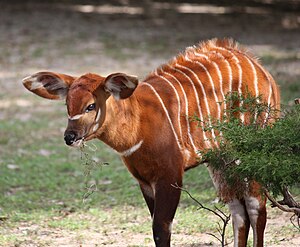
Back بوابة:تنزانيا Arabic Portal:Tansania German Portal:Tanzania Spanish Portail:Tanzanie French Portal:Tanzania Galician Portal:Tanzania Malay Portal:Tanzânia Portuguese Portal:Tanzania Swedish Lango:Tanzania Swahili Портал:Танзанія Ukrainian
 The Tanzania Portal
Tanzania, officially the United Republic of Tanzania, is a country in East Africa within the African Great Lakes region. It is bordered by Uganda to the northwest; Kenya to the northeast; the Indian Ocean to the east; Mozambique and Malawi to the south; Zambia to the southwest; and Rwanda, Burundi, and the Democratic Republic of the Congo to the west. Mount Kilimanjaro, Africa's highest mountain, is in northeastern Tanzania. According to the 2022 national census, Tanzania has a population of nearly 62 million, making it the most populous country located entirely south of the equator. Many important hominid fossils have been found in Tanzania, such as 6-million-year-old Pliocene hominid fossils. In the Stone and Bronze Age, prehistoric migrations into Tanzania included Southern Cushitic speakers who moved south from present-day Ethiopia; Eastern Cushitic people who moved into Tanzania from north of Lake Turkana about 2,000 and 4,000 years ago; and the Southern Nilotes, including the Datoog, who originated from the present-day South Sudan–Ethiopia border region between 2,900 and 2,400 years ago. These movements took place at about the same time as the settlement of the Mashariki Bantu from West Africa in the Lake Victoria and Lake Tanganyika areas. In the late 19th century, the mainland came under German rule as German East Africa, and this was followed by British rule after World War I when it was governed as Tanganyika, with the Zanzibar Archipelago remaining a separate colonial jurisdiction. Following their respective independence in 1961 and 1963, the two entities merged in 1964 to form the United Republic of Tanzania. Tanganyika joined the British Commonwealth and Tanzania remains a member of the Commonwealth as a unified republic. Tanzania is mountainous and densely forested in the north-east, where Mount Kilimanjaro, the highest mountain in Africa and the highest single free-standing mountain above sea level in the world, is located. Three of Africa's Great Lakes are partly within Tanzania. To the north and west lie Lake Victoria, Africa's largest lake, and Lake Tanganyika, the continent's deepest lake, known for its unique species of fish. To the south lies Lake Malawi. The eastern shore is hot and humid, with the Zanzibar Archipelago just offshore. The Menai Bay Conservation Area is Zanzibar's largest marine protected area. The Kalambo Falls, located on the Kalambo River at the Zambian border, is the second-highest uninterrupted waterfall in Africa. Tanzania is one of the most visited tourist destinations for safaris. Selected article -The Uganda–Tanzania War, known in Tanzania as the Kagera War (Kiswahili: Vita vya Kagera) and in Uganda as the 1979 Liberation War, was fought between Uganda and Tanzania from October 1978 until June 1979 and led to the overthrow of Ugandan President Idi Amin. The war was preceded by a deterioration of relations between Uganda and Tanzania following Amin's 1971 overthrow of President Milton Obote, who was close to the President of Tanzania, Julius Nyerere. Over the following years, Amin's regime was destabilised by violent purges, economic problems, and dissatisfaction in the Uganda Army. The circumstances surrounding the outbreak of the war are not clear, and differing accounts of the events exist. In October 1978, Ugandan forces began making incursions into Tanzania. Later that month, the Uganda Army launched an invasion, looting property and killing civilians. Ugandan official media declared the annexation of the Kagera Salient. On 2 November, Nyerere declared war on Uganda and mobilised the Tanzania People's Defence Force (TPDF) to retake the salient. Nyerere also mobilised Ugandan rebels loyal to Obote and Yoweri Museveni to weaken Amin's regime. After Amin failed to renounce his claims to Kagera and the Organisation of African Unity (OAU) failed to condemn the Ugandan invasion, the TPDF occupied the towns of Masaka and Mbarara in southern Uganda. (Full article...)General images -The following are images from various Tanzania-related articles on Wikipedia.
This month in Tanzanian history
Wildlife of Tanzania - Credit: Trisha Shears
The western or lowland bongo, Tragelaphus eurycerus eurycerus, is a herbivorous, mostly nocturnal forest ungulate and among the largest of the African forest antelope species. Bongos have a reddish-brown coat, black and white markings, white-yellow stripes and long slightly spiralled horns. Indeed, bongos are the only Tragelaphid in which both sexes have horns. Bongos have a complex social interaction and are found in African dense forest mosaics. Did you know ...
CategoriesWikiProjectsRecognised contentSelected panorama -Skyline of the Dar es Salaam city center.
Uganda–Tanzania War -Articles here focus upon aspects of the Uganda–Tanzania War. These are all Good articles that meet a core set of high editorial standards.
The Battle of Mutukula (Kiswahili: Mapigano ya Mutukula) took place from 21 to 22 January 1979 near and in the town of Mutukula, Uganda, during the Uganda–Tanzania War. After repulsing a Ugandan invasion of the Kagera Salient in 1978, Tanzanian commanders feared that Ugandan forces stationed upon the high ground in Mutukula, a town located along the Tanzania–Uganda border, still posed a threat to their territory. On the night of 21 January 1979 the Tanzanian 208th Brigade crossed the border and surrounded the town. The following morning it attacked, and the Ugandan garrison—including the Gondo and Suicide Battalions—fled. Afterwards the Tanzanians razed the locale in revenge for the damage wrought by the Ugandans in Kagera. (Full article...) TopicsSelected picture - Credit: Muhammad Mahdi Karim
A farmer walks towards sisal plantations in the outskirts of Morogoro, Tanzania. The Uluguru Mountains can be seen in the background. Tanzania is the world's fourth largest sisal producer. It is traditionally used for making rope, twine, paper, wall coverings and carpets. ...Archive — Nominations
Related portalsThings you can doAssociated WikimediaThe following Wikimedia Foundation sister projects provide more on this subject:
Discover Wikipedia using portals | ||||
© MMXXIII Rich X Search. We shall prevail. All rights reserved. Rich X Search








































































